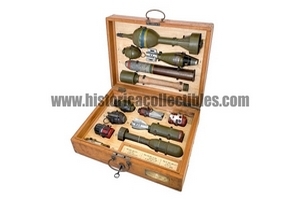Educational Box for Elementary Schools, No. 13 Inert Teaching Ordnance, circa 1940
Educational box made up of 13 inert explosive devices dated to around 1940, totally inertised (the cassette is accompanied by a detailed document which confirms and certifies its total inertisation in accordance with the law by the competent authority), used and distributed immediately after the war , from the Higher Technical Institute of Artillery, to all elementary schools to facilitate teachers in the instruction and identification of these devices, to all pupils who attended elementary primary school, so that all children became aware of the danger of such objects in the event that they had found them in exchanges, gardens or environments frequented by them and which, until a few years earlier, were the scene of the Second World War.
In fact, despite the efforts of the deminers, many weapons of war still remained scattered across our territory, constituting a major danger especially for children, who often, not understanding their danger, picked them up and played with them. Among teenagers there were deaths or mutilations due to the accidental explosion of bombs.
To reduce the number of accidents, a vast information campaign was started, mainly in primary schools in rural areas, to make children aware of the dangers of the bombs that could be found. Posters were put up, showing children who were victims of explosions due to having carelessly handled weapons of war, and where the most common types of bombs and grenades were illustrated so that children would learn to recognize them, inviting them to alert the Carabinieri in case of discovery. Wooden boxes containing a sample of explosives were also distributed to the schools, obviously without the explosives, so that the teachers could show them to the children, even letting them touch them. Obviously in this case the impact was greater than seeing them reproduced on a poster hanging on the school walls and therefore it was thought that by seeing them in real life they would be able to identify them better and avoid accidents.








